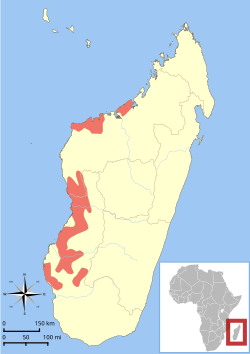| Pale fork-marked lemur | |
|---|---|
 | |
| Scientific classification | |
| Kingdom: | Animalia |
| Phylum: | Chordata |
| Class: | Mammalia |
| Order: | Primates |
| Suborder: | Strepsirrhini |
| Family: | Cheirogaleidae |
| Genus: | Phaner |
| Species: | P. pallescens |
| Binomial name | |
| Phaner pallescens | |
 | |
| Pale fork-marked lemur range [1] | |
The pale fork-marked lemur (Phaner pallescens), or western fork-marked lemur, is a species of lemur known from western Madagascar; south of the Fiherenana River to the region of Soalala. It is said to be the smallest fork-marked species. [4] It is listed on CITES Appendix I as Endangered. [2] They are about 9–11 in (230–280 mm) long from head to rump and their tail adds another 11–15 in (280–380 mm). Pale fork-marked lemur's weigh around 11–18 oz (310–510 g)
Pale fork-marked lemurs live up to around 12 years in captivity. Their chances of surviving to that age is suspected to decrease when in the wild. [5]
